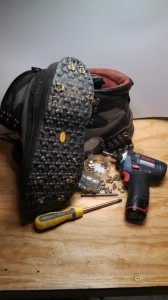A Little “Stud Service” can go a long way when it comes to keeping a wading fisherman erect and dry! Studs and Cleats are the latest technology to help wading fishermen stay on their feet! No one wants to do the “Boot Scoot Boogie” as they slip and slide into a freezing cold river. For most of us careful waders, we just want to stay warm and dry without leaks. For others, it’s about more “Action Traction”.
 Several states have now made the popular felt soles against the rules. Apparently, the wet felt can transfer Whirling disease, snails and alien algae crud. In the past I have strapped, glued and attached, chains, carpet remnants, and aluminum bars to my boot soles. Plain rubber boot treads were just not enough especially as they wore out.
Several states have now made the popular felt soles against the rules. Apparently, the wet felt can transfer Whirling disease, snails and alien algae crud. In the past I have strapped, glued and attached, chains, carpet remnants, and aluminum bars to my boot soles. Plain rubber boot treads were just not enough especially as they wore out.
Studs and Cleats are the new and better choice when improving your wading shoes. Most new wading boots are fitted with an especially designed Vibram sole. This stiff and durable material allows you to screw in metal accessories to improve traction. Depending upon where you fish, you may not need to add more metal to the already traction designed tread.
Studs and Cleats do have a down side. They can damage a boat deck and are loud when walking in the water. Many guides do not allow them in their drift boats. Fortunately, these metal “Traction” screws are easily removed. If you do a lot of hiking in your wading boots, you may want to remove the metals studs and cleats for the journey.
Commercially made Studs and Cleats are pricy. Several companies make different styles and variations. Each product has a unique feature to attract buyers. You may also want to consider screws that are made to apply to motorcycle tires for traction. They are less expensive and also work well. Aluminum hex head screws wear out quickly but almost stick to slippery rocks. Stainless steel screws also work and last longer.
No glue is needed when applying Studs and Cleats or self- tapping screws. Make sure to check the length when selecting a homemade choice of aluminum or stainless steel screws. Be careful not to penetrate beyond the thickness of your boots soles.
When attaching Studs and Cleats to your wading boots, arrange them around the perimeter or edge of the boot’s sole. 8 per boot are plenty but everyone’s feet and needs vary. Start with the perimeter pattern and see how it works. Adjust your Stud and Cleat footprint as needed. I have found that too much hardware can actually reduce contact with the ground and become too slippery. I like at least 4 on my heel and the rest toward the toe of my wading boot.
Routine Stud Service is necessary to maintain good traction. Carry a hex head tool with you to facilitate any repairs. Do not over tighten the screws or glue them into place. It is important to be able to change or remove the hardware in some situations.
Another great way to stay upright and dry when wading is to wear a pair of decent Polaroid sunglasses. These glare reducing glasses allow you to see the depth and obstacles before you discover them the hard way.
A sturdy walking stick is also a nice addition to carry when you need a “third leg” for support. There are some wonderful lightweight foldable and holstered walking sticks that you wear on your belt. I also wear my Wading Boots when fishing on rock jetties or wood piers. The extra traction allows me to move without sliding and falling.
A wise old fishing Buddy once told me, ”if you are standing knee deep in the water, you should be fishing where you are standing”. He was so right, but adding a Little “Stud Service” helps too!
Stay upright and dry!
Montana Grant
